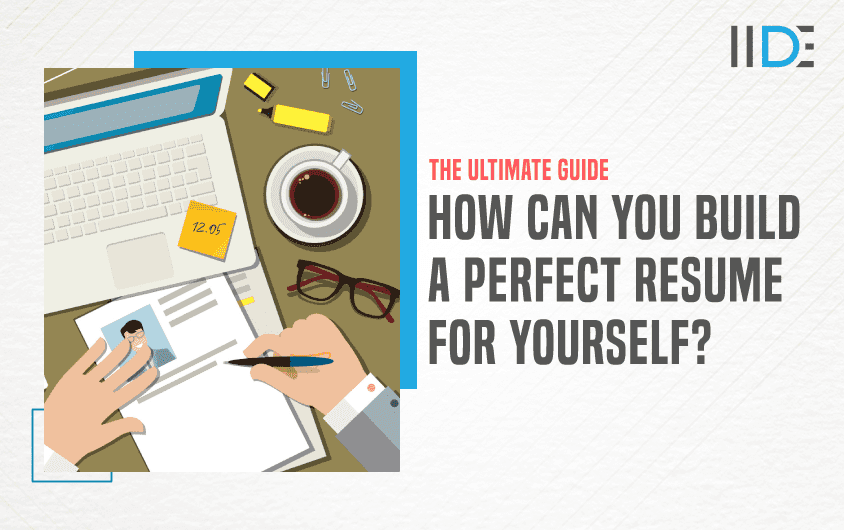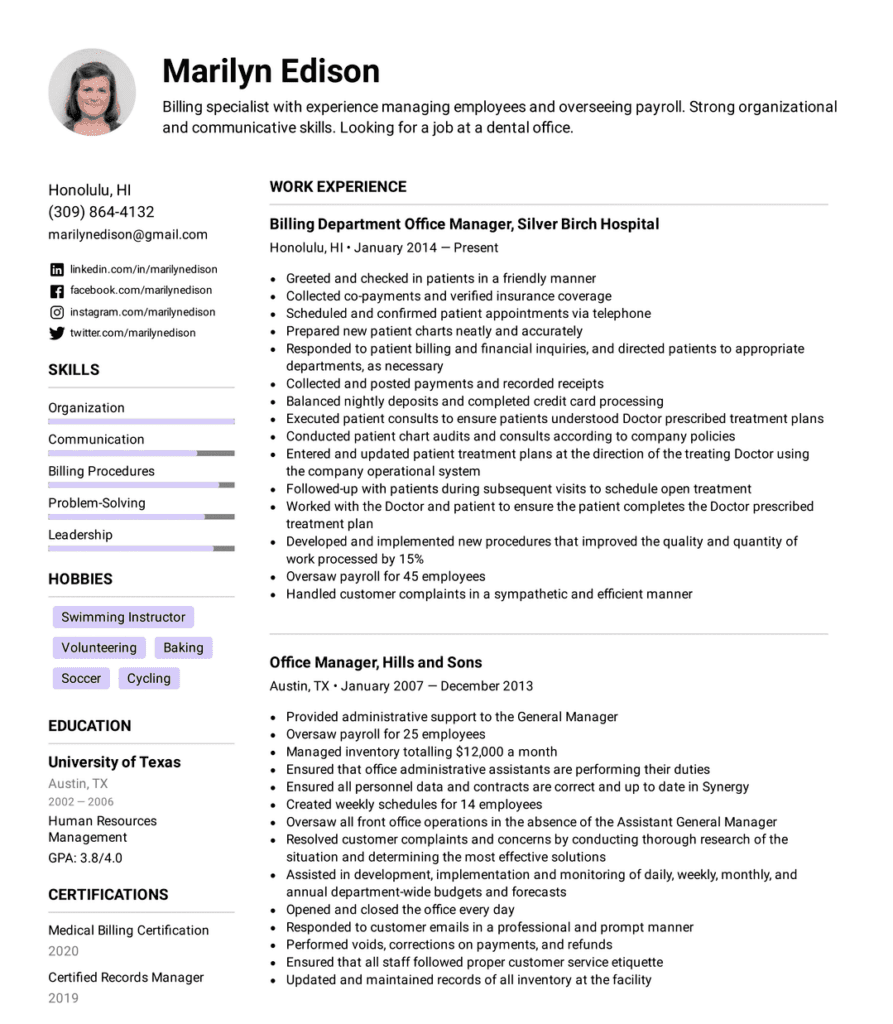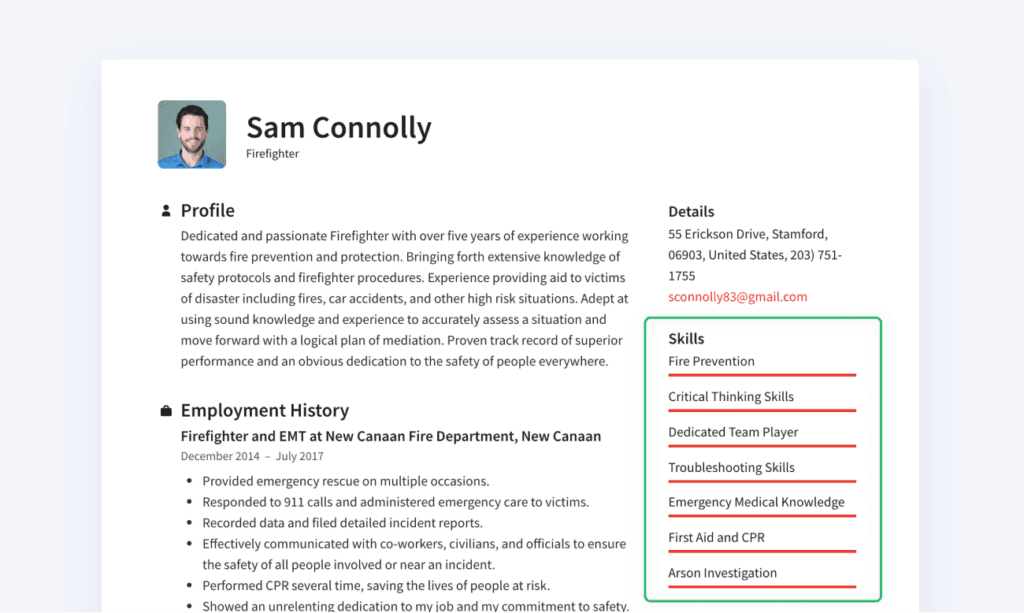Join an online Q&A session with the Director of Student Success to explore what your experience as an IIDE student will be like. Register Now.
Students Centric
Placements Report
Trackable results, real numbers
Reviews
Proven success, real voices
Trainers
Expert-led, Industry-Driven Training
Life at IIDE
Vibrant Spirit student life
Alumni
Successful Journeys, Inspiring Stories
Learning Centre
Webinars
Blogs
Case studies
Live, Interactive Masterclasses
Fresh Insights, quick reads
Real-life, Industry relevant
More
Hire from us
Hire Top Digital Marketing Talent
Work with us
Join Our Team, Make an Impact
Customised Training
Personalised digital marketing training for your company
Refer & earn
Simple, easy rewars
Contact us
Get the answers you need
About us
Know more about IIDE
Explore all course options
Trending
Professional Certification in AI Strategy
- Ideal for AI Enthusiast

Updated on Sep 25, 2025
What if someone asks you ‘write in short what you are, how you are?’ Think of a resume like this. A deaf super busy billionaire is looking for a new CEO for his global company. The yearly salary for this position was going to be 1.5 million dollars.
The billionaire knew that a lot of candidates would apply for this job. Since he was deaf, he preferred people to communicate with him in writing. Also because he was forever busy, he wanted interested candidates to tell him about themselves in not more than 2 pages.
A strong and perfect resume is the most important thing for you to get your dream job. If you write a good resume, you’ll get responses from every organization you apply to.
Now many of you might have some questions like “How to make a resume for my first job”, or “How to make a resume with no experience”. Don’t worry, you’ll get all your answers throughout the blog.
Check This Out: 50+ Digital Marketing Interview Questions & Answers in 2021
In this blog, we will discuss everything you need to know while writing a perfect resume even for freshers.
Let’s start with the meaning of a Resume.
What is a Resume?
A resume is a brief, and to-the-point document designed to apply for a specific job. The resume should be as short as possible and brief.
In simple words, a resume is a document created by you to sell yourself (your services) to the company. It should be better than anybody else’s document. It should have everything interesting in it for the reader to read about you. Lastly, whatever you mention in it should be 100% true.
What should you tell in a Resume?
A summary of your work experience and educational history that is relevant to the job you are applying for should be included in your resume. Certain skills and what helps you stand apart from others should be included.
An effective resume highlights particular contributions you made in past jobs and shows how your various capabilities might be applied to the job you’re seeking for. Here’s a breakdown of the essential elements of a resume:
Top 9 Essential Elements of a Resume –
- Full Name
- The name of the position you’re applying for, or your job title
- Contact information
- Resume summary or objective
- Education
- Work Experience
- Language and proficiency
- Relevant Skills
- Relevant Certifications and Interests
Remember you have limited space i.e. you’ve to write it in max two pages. So whatever you state should be things about your life that should probably interest the interviewer. Keep it short, concise, and interesting.
Here’s a step-by-step process of how to make a resume.
9 Easy Steps on How to Make a Resume
Many of you would be thinking that “How do I make my Resume?”, or “How do you write a resume for the first time?”. Don’t worry, we have answers to all your questions.
We have stated some simple steps by which you can prepare a perfect resume for yourself.
1. Select the Right Resume Format & Layout
The first and most important step in preparing a resume is to choose a format that is appropriate and suitable for your resume.
You can’t just shuffle your information and put it together in the template. You must follow a particular layout.
You can choose one of the following formats for your resume.
- Reverse-chronological Format – The chronological resume is a classic resume structure that highlights your responsibilities, experience, and work history. You’ll start with your most recent positions and go back through past jobs in reverse chronological order. It’s the easiest to read and scan because it’s the standard, basic resume format.

- Combination Format – For job seekers with a wide range of skills, a combination resume format is an excellent option. It’s beneficial if you’re searching for a job that demands knowledge of three or four different fields and you want to demonstrate it all on your resume.
- Functional Format (Skill-based) – If you are a student or a recent graduate and lack relevant work experience, or you are looking to shift your career, then the skill-based resume template will be the best option for you.
INTERESTING FACT: Most job applicants are likely to choose the Reverse-Chronological resume template.
Once you have decided which resume format you are going to use while making your resume, here’s the next step.
2. Add Your Personal Detail & Contact Information
You must know what information should be provided and what are the things which you’ve to hold back.
Similarly, on a perfect resume contact information section, there are some basic items that you must include and a few of them you should leave out.
The necessary information you must include are –
- Name
- Phone Number
- Email Address
- LinkedIn URL
The optional information is as follows –
- Resume title
- Personal Website
The contact information which you should avoid are –
- Date of Birth
- Second Email or Phone Number
- Photo
TIP: You must include your LinkedIn URL, social media, or personal website (if any) because these are the most common things nowadays to write in the resume.
3. Must include Resume Summary or Resume Objective
We all are aware that first impressions matter, whether in your personal life or your professional life.
If you make a negative and bad first impression, chances are it will stick with you for the rest of your life. After all, it’s difficult to change someone’s mind about you.
According to the HR statistics report, the hiring manager scans your resume and makes the final decision within 7 seconds.

So you must include a professional resume heading statement and objective, that portraits an attractive image of yourself.
Because it’s at the top of the page, your resume summary statement or resume objective statement is likely to get the most attention.
You May Also Be Interested In: Scope of Digital Marketing in India – Covid Updated
4. Mention Your Relevant Work Experience and Key Achievements
Your resume experience section is the most important part of your resume despite anything else.
Below given are some pointers which you must follow while formatting your job experience section on your resume.
- Job Designation/Position – Your job position should go at the very top of each work experience entry so that it becomes easy for the employers to scan and find. Try to make it bold or highlight it and increase the font size by 1pt or 2pt from the rest.
- Company Name, and Location – Just after writing your job title, mention the previous company’s name and its location, i.e. state, city, etc. You can also describe the company in 1 or 2 lines if you want.
- Employment Duration/ Dates – After this, include the duration of your job. You can include the year or both the month and the year, but no exact dates are required.
- Key Achievements and Responsibilities – This is the most important part of the job experience section. You have to mention your key responsibilities in the previous company you’ve worked. And also your achievements out there. Because employers are interested in not only what you did, but also how well you did it.

Some small yet important things which you’ve to keep in mind while formatting the job experience section are –
- If you’re adding more than one job history in your resume, then start with the most recent one and go in the reverse-chronological order from there.
- Use 4 or 5 bullet points while writing your responsibilities and achievements point.
- And in case you don’t have much professional work experience then try to put your education section above your work history.
- Finally, avoid using passive voice in your resume because it appears ambiguous and unclear; instead, use active voice because it is brief and to the point.
5. List Your Education Qualification
The next thing which you’re going to include in your resume is your education. Most individuals disregard the education section, but you should not do so. It’s an essential part of your resume’s structure.
Let’s take a look at how to format and structure the education section and what to mention there.
- Program Name,
- University Name,
- Year’s attended,
- GPA (optional),
- Honors (optional),
- Academic achievements (optional),

Given below are some tips on How to put education on your resume.
- The right resume education order is to place your highest degree first.
- Add any other degrees after in reverse-chronological order.
- If you finished a university degree, don’t add high school info.
- Add any relevant coursework, honors, or awards you received.
- Extracurricular activities are a nice finishing touch.
- If you’ve little or no work experience, then list it above the work experience section.
- If your GPA is not perfect (less than 3.5) then you can exclude that from your resume, because it will only count against you.
- The most important thing to remember is to never lie on your resume. Mention all the genuine points, not just in this section but throughout your resume.
6. Put the Relevant Skills that Fit the Job Ad

Another must-have section in your resume is the “Skills” section. There are two types of skills you can include while writing your resume.
- Hard skills – Hard skills are some specific abilities in your resume. This can be anything from coding in python or knowing any technical stuff. Your measurable abilities come under your Hard skills.
- Soft-Skills – These are your personal skills. It is the mix of your communication skills, social skills, personal traits, career attributes, and so on. For example – leadership, communication, management, critical thinking, etc.
Given below are some of the common skills which you can put on your resume-
- Communication skills – It includes non-verbal communication, social, interpersonal, and listening skills.
- Technical Skills – These are some specific skills where knowledge is required to perform some special tasks, such as clerical skills, computer skills, etc.
- Leadership and Management Skills – These skills include some special abilities to become a good manager, leader, or supervisor.
- Job Specific Skills – Particular skills which a company requires from you to carry on some specific task in the organization.
- Critical Thinking Skills – It is the ability to make your own thought-based decisions and take initiative. It contains your analytical skills, problem-solving, and decision-making.
- Organizational Skills – This includes a talent for planning, arranging, and completing projects.
- Transferable Skills – These are the skills you learned in your previous job that you can use in your new one.
Let’s take a look at some important points which you have to keep in mind while formatting your skills section on your resume.
- Always list your hard skills with your experience level. With each hard skill you list, mention your proficiency level. You can divide it as Beginner, Intermediate, Advanced and Expert level.
- You have to tailor your skills as per the job requirements. For example, you may have very nice accounting skills but if you are going to an interview for a software developer then the skill might not be useful for you.
- You can include some of the Universal skills, which are needed in almost every field. It includes both hard and soft skills. It can be Writing, leadership, MS Office, Communication, Photoshop, etc.
Quick Tip: if you don’t have any skills to mention over your resume then we recommend learning the most universal skill, i.e. “Digital Marketing”, which is a highly preferred skill to have on your resume.
You can check out our online digital marketing course to enhance your digital marketing skill, simply by sitting in the comfort of your home in under 3 months!
And if you want to be more specific then, you must check out our short-term certification courses in digital marketing such as SEO, SEM, Social Media Marketing, WordPress, Content Marketing, Google Ads and many more.
7. Include Additional Important Resume Section
What sets you apart from the others in the above-mentioned sections of their resumes?
Here’s how to do it: add some extra sections to your resume to make yourself stand out from the throng.
Below stated are some points or sections which you can add to your resume to make your resume look good and different from others.
Certifications and Awards
If you have any certifications or awards that make you stand out in your field from others or which are relevant to your job and industry, then you must include them.
For example, you are a digital marketer and you have got a special award or appreciation letter from the industry experts then you can mention that in your resume. It will give you a boost.
Languages
If you can speak more than one language, then that’s an impressive thing, and you can mention that on your resume.
Language abilities on a resume will increase your value as an employee, especially in international organizations or areas where that second language is spoken by a significant population.
Simply write down the languages you want to include in your Resume and allocate them to the proper level:
- Native
- Fluent
- Proficient
- Intermediate
- Basic
You should never, ever lie about your language skill. You never know, your interviewer might show out to be a native speaker or even fluent in that particular language!
Some more sections which you can include are –
- Volunteering Work
- Hobbies and Interests
- Publications
- Projects
8. Complement your resume with a Cover Letter
Every job application consists of two parts – the resume and the cover letter. Now we have covered the resume section, let’s take a look at the cover letter.
The majority of the employer think that your resume is not enough to make a decision, so you also have to include a cover letter.
What exactly is a cover letter and what should we write in it?
It’s simple, the cover letter is kind of a direct message to the employer or the hiring manager, where you briefly mention, why are you a perfect fit for the position.

Here’s a format you can follow to write a cover letter.
- Introduction
- How are you a perfect fit for the job
- Sum up and say thanks
9. Proofread Your Resume
You are almost done, but don’t send it right away.
The most significant step before sending your resume is to double-check it. You must scan your resume and your cover letter with some tools like Grammarly. And ask someone to triple-check it again. Better safe than sorry!
And once you’ve done all these things, you’re ready with your perfect resume. Now you can send this to the employer.
Now let’s see some of the resume-building tools which you can use to format your resume.
Resume Building Tools & Templates
If you are too lazy to make a template for your resume or to make it on MS Word by yourself, then there’s an alternative option.
We have listed some of the best tools that will help you to create an optimum structure for your resume, catch the errors, make it quirky and even optimize for the ATS (Application Tracking System), that many firms use nowadays.
For those who are not aware of what ATS means, it is basically software used by many companies that helps them to filter hundreds of resumes they receive per day according to their requirements.
Given below are those tools –
Something that we noticed is that not many people are aware of the difference between a CV and a Resume and no, they’re not the same. So, let’s check out the major difference between the two.
Difference between a CV and a Resume

Most people are unaware of the difference between a resume and a CV. Many times people get confused between the two.
So, to clear all your doubts, we’ve listed few facts that will explain how a CV differs from a resume.
1. Meaning
A Resume is a to-the-point document made to apply for a specif job, whereas a CV is a detailed document that describes your career journey step-by-step, including all sorts of personal information.
2. Length
A resume must be short and brief (usually 1 or max. 2 pages), whereas a CV is more comprehensive and in-depth (can be of 2-5 pages depending upon your experience).
3. Purpose
A Resume is written for a regular job position in a company, whereas the CV is mostly used for academic objectives, such as applying for a research program, a PhD, or becoming a member of a university’s faculty.
4. Type of Information
The CV is an academic journal in which you record all of your academic accomplishments, awards, and certificates. A Resume, on the other hand, must be written (or at least customized) for each job you apply for, and it places a greater emphasis on your professional accomplishments rather than your academic achievements.
5. Audience
One of the biggest differences between a resume and a CV is in the audience. A CV speaks largely to an academic audience and documents your academic and intellectual accomplishments. On the other hand, a resume is read by hiring managers in a non-academic organization and should be tailored to this group.
Now before we wrap up, we have some additional special tips and suggestions for you to make your resume the perfect one. So, let’s dive into it and see what are those.
Lastly, Our Special Tips on How to Make a Resume
- Be consistent and use the same formatting, styles, colours, and conventions throughout the resume.
- As we have mentioned earlier, do cross-check your resume before checking, whether there are some typos or errors.
- Use a proper format to write your resume.
- Everything which you have mentioned in your resume must be tailored according to the job you’re applying for.
- As we stated earlier, don’t lie on your resume. Sometimes the employer might cross-check your resume, whether the information you’ve given is correct or not.
- You should make sure that every single item on your resume should be directed towards proving that you are the best suitable candidate for the job.
- Design a perfect cover letter, it’s as important as your resume. So make sure to give equal attention and detail to it.
That’s about it! This is the ultimate guide on “How to make a resume”. And if you’ve read the entire blog then you’re ready to make your resume now.
If you’re just starting out in your career and are looking for options, consider checking out this 11-month MBA-Level Post Graduation in Digital Marketing which comes with guaranteed placement assistance with an average starting package of 5+ LPA.
Let our team of counsellors help you understand what digital marketing has to offer and if this program is right for you. Write to us today for a free counselling session.
We hope this blog has helped you with your resume formatting process. Let us know about your views in the comments section below.


Learn Digital Marketing for FREE
- 45 Mins Masterclass
- Watch Anytime, Anywhere
- 1,00,000+ Students Enrolled


Want to Know Why 2,50,000+ Students Trust Us?
Dive into the numbers that make us the #1 choice for career success

Courses Recommended for you
MBA - Level
Post Graduate in Digital Marketing & Strategy
Best For
Fresh Graduates
Mode of Learning
On Campus (Mumbai & Delhi)
Starts from
Jan 5, 2026
Duration
11 Months
Live & Online
Advanced Online Digital Marketing Course
Best For
Working Professionals
Mode of Learning
Online
Starts from
Jan 5, 2026
Duration
4-6 Months

Online
Professional Certification in AI Strategy
Best For
AI Enthusiasts
Mode of Learning
Online
Duration
5 Months

Offline
Undergraduate Program in Digital Business & Entrepreneurship
Best For
12th Passouts
Mode of Learning
On Campus (Mumbai)
Duration
3 Years
Recent Post
- 9 Best Courses After 12th in Jaipur 2025: Top Colleges, Eligibility & Career Prospects
- 11 Best Courses After 12th in Ahmedabad 2025: Top Colleges & Careers
- Top 10 Best Courses After 12th in Nagpur 2025: Eligibility, Top Colleges & Career Scope
- Top 15 Courses After 12th in Udaipur 2025: Best Colleges, Eligibility & Career Scope
- Top 14 Courses After 12th in Nashik 2025: Best Colleges, Eligibility & Career Scope
- Best 12 Courses After 12th in Raipur 2025: Top Colleges, Eligibility & Career Prospects
- 7 Best BBA Courses in Udaipur for 2025: Top Colleges, Fees & Career Prospects
- 8 Best BBA Courses in Raipur for 2025: Top Colleges, Fees & Career Prospects
- 8 Best BBA Courses in Nashik for 2025: Top Colleges, Fees & Career Prospects
- 5 Best Commerce Colleges in Udaipur 2025 - Fees, Scholarships, Placements & More
Digital Marketing Courses Nearby
- Digital Marketing Courses in Taiping
- Digital Marketing Courses in Sungai Petani
- Digital Marketing Courses in Subang Jaya
- Digital Marketing Courses in Sibu
- Digital Marketing Courses in Shah Alam
- Digital Marketing Courses in Seremban
- Digital Marketing Courses in Sandakan
- Digital Marketing Courses in George Town
- Digital Marketing Courses in Bukit Mertajam
- Digital Marketing Courses in Grimsby
Kartik is a certified digital marketer and an experienced marketing trainer with a strong passion for imparting knowledge in the field of digital marketing. As a marketing leader, he brings expertise in SEO (Search Engine Optimization), ASO (App Store Optimization), Website Development & much more. His curiosity and commitment to staying updated with industry trends have made him a dedicated digital marketing educator.
Kartik's dedication to teaching has led him to train over 35,000 students globally. His students range from engineers, MBA graduates, start-up entrepreneurs, marketing managers, and even those new to the world of digital marketing. His sessions have reached learners across India, Canada, Dubai, the USA, and other parts of the globe.
Kartik is committed to helping students and professionals alike understand the complexities of digital marketing, empowering them to advance their careers and businesses in this dynamic industry. His deep knowledge and practical approach have earned him a reputation as top 1% digital marketing trainer.